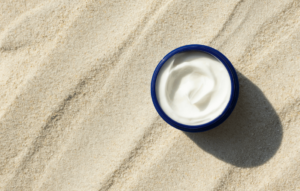Sunscreen has long been seen as a modern-day essential for protecting our skin against harmful ultraviolet (UV) rays. There have always been some critiques of our dependence on these products, but as we increasingly wake up to how many things we’ve gotten wrong with our health, there has been an uptick in questions about their impact.
Concerns are growing about sunscreen, not just for our health but also for that of the environment. Are we relying too much on a chemical solution without considering its long-term consequences? This blog explores the hidden costs of sunscreen, the environmental damage it’s done and is still doing, and why a balanced, more nuanced approach to sun protection might be the key to protecting ourselves and the planet.

The Biological Argument Against Sunscreen
For centuries, humans thrived under the sun without access to modern sunscreens. While severe sunburns were likely avoided through natural adaptation and cultural practices, skin cancer was far less common in history compared to today. So, why has there been a dramatic increase in skin cancer rates despite the widespread use of sunscreen?
From an evolutionary perspective, humans developed darker skin pigmentation in sunnier regions as a natural defense against harmful UV radiation. Clothing and shade offered additional protection long before sunscreen was invented. The industrial era brought significant changes to how we live – spending more time indoors, adopting artificial lighting, and losing natural sun exposure cycles. This shift coincides with an increase in certain health issues, including skin cancer, raising the question: are we addressing the problem incorrectly?
sunnier regions as a natural defense against harmful UV radiation. Clothing and shade offered additional protection long before sunscreen was invented. The industrial era brought significant changes to how we live – spending more time indoors, adopting artificial lighting, and losing natural sun exposure cycles. This shift coincides with an increase in certain health issues, including skin cancer, raising the question: are we addressing the problem incorrectly?
Some researchers suggest that sunscreen usage, particularly when over-relied upon, could lead to more harm than good. By creating a false sense of security, sunscreens might encourage prolonged sun exposure, increasing the likelihood of UV damage. Moreover, many sunscreens block UVB rays (responsible for sunburn) while allowing UVA rays, which penetrate deeper into the skin, potentially causing more significant long-term damage.
The Problem of Toxic Ingredients
Chemical sunscreens are formulated with active ingredients like oxybenzone, octinoxate, and avobenzone. While effective at absorbing UV rays, these chemicals come with a host of concerns for human health. Oxybenzone, for instance, has been linked to hormone disruption, skin allergies, and potential risks to fertility. Octinoxate, another common ingredient, has been shown to contribute to oxidative stress in skin cells when exposed to UV rays, which ironically may accelerate skin aging – the very thing sunscreen is supposed to prevent.
It should also be noted that these chemicals aren’t inert once absorbed by the skin. Studies have found traces of sunscreen chemicals in the bloodstream, urine, and even breast milk, raising concerns about their systemic effects. This begs the question: are we prioritizing sun protection at the cost of our overall health?
Environmental Impact
The issues with chemical sunscreens extend beyond human health – they also can cause serious damage to marine ecosystems. Every year, up to 14,000 tons of sunscreen wash off swimmers, snorkelers, and beachgoers into the ocean. Chemicals like oxybenzone and octinoxate are known to be highly toxic to coral reefs, contributing to a phenomenon called coral bleaching, where coral loses its vibrant color and eventually dies.
Research conducted in popular tourist destinations like Hawaii and the Great Barrier Reef has demonstrated the devastating impact of sunscreen pollution. In fact, the harm is so severe that Hawaii and other locations have banned certain chemical sunscreens to protect their fragile ecosystems. But coral reefs aren’t the only victims. These chemicals also affect marine life, disrupting reproductive systems in fish, sea urchins, and other species.
Better Ways to Protect Your Skin
Given the risks associated with chemical sunscreens, it’s time to rethink how we approach sun protection. Thankfully, there are safer and more sustainable alternatives available.
Mineral-Based Sunscreens
Mineral-based sunscreens, which use zinc oxide or titanium dioxide as active ingredients, offer a reef-safe and skin-friendly option. These minerals sit on the skin’s surface and reflect UV rays rather than absorbing them, making them less likely to cause systemic health issues. Additionally, they are biodegradable and do not harm coral reefs or marine life when washed off in the water.
When choosing a sunscreen, look for labels that say “reef-safe” or “non-nano,” as these indicate products free from harmful chemicals and formulated with environmentally friendly ingredients.

Natural Precautions
While mineral sunscreens are a step in the right direction, the most effective and sustainable solution might be to reduce our reliance on any type of sunscreen altogether. Here’s how:
- Protective Clothing: Wear long-sleeved shirts, wide-brimmed hats, and sunglasses to shield your skin from direct sunlight. Many modern fabrics offer built-in UV protection.
- Seek Shade: Avoid prolonged exposure during peak sunlight hours, typically between 10 a.m. and 4 p.m.

- Time Your Exposure: Moderate sun exposure is essential for vitamin D production, but overexposure leads to skin damage. Find a balance that works for your health.
These simple tweaks, combined with a mineral-based sunscreen for necessary coverage, can significantly reduce the risk of UV damage without relying solely on potentially harmful products.
Rethinking the Sunscreen Debate
The cultural narrative surrounding sunscreen often paints it as a must-have item for health and safety. However, this oversimplification ignores the complexities of the issue. Chemical sunscreens, while convenient, introduce a host of problems that we can’t afford to ignore any longer. If they are made with toxins, they can harm our bodies through potential endocrine disruption and oxidative stress, not to mention the devastation of our marine ecosystems via polluting oceans and killing coral reefs.

Instead of treating sunscreen as a cure-all, we should view it as just one tool in a broader strategy for sun protection. By combining safe, mineral-based sunscreens with natural methods like protective clothing and being smart with our sun exposure, we can protect ourselves without compromising our health or the environment.
Wrapping Up
It’s time we question our blind reliance on cheaply made chemical sunscreens. The evidence is clear: many of these products not only fail to provide adequate protection but also harm the very ecosystems we depend on. By opting for safer alternatives and adopting smart sun exposure habits, we can create a healthier balance between shielding our skin and safeguarding the planet.
evidence is clear: many of these products not only fail to provide adequate protection but also harm the very ecosystems we depend on. By opting for safer alternatives and adopting smart sun exposure habits, we can create a healthier balance between shielding our skin and safeguarding the planet.
So let’s embrace a more thoughtful approach to sun protection – one that respects both our biology and the environment. After all, true wellness extends beyond ourselves; it encompasses the health of the world we inhabit.









